26 Best Sales Automation Tools & Software to Boost Your Revenue
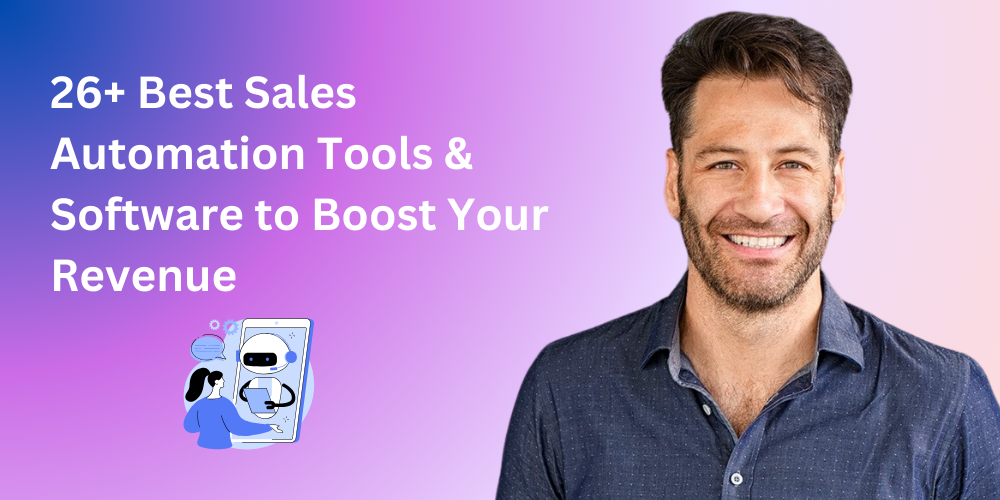
Sales automation is all about working smarter. With longer sales cycles and more elusive buyers, the right tools can save you time—up to six hours a week, according to 60% of workers. And with 74% of sales pros expecting AI to reshape their roles, automation isn’t optional anymore—it’s essential.
We’ve curated the best sales automation tools, complete with fresh features, honest pros and cons, and current pricing.
Sales automation is all about working smarter. With longer sales cycles and more elusive buyers, the right tools can save you time—up to six hours a week, according to 60% of workers. And with 74% of sales pros expecting AI to reshape their roles, automation isn’t optional anymore—it’s essential.
We’ve curated the best sales automation tools, complete with fresh features, honest pros and cons, and current pricing.
What Is Sales Automation Anyway?

Sales automation is the process of using software, artificial intelligence, and digital solutions to automate repetitive and time-consuming sales tasks. This includes things like sending emails, organizing follow-ups, managing customer data, and keeping track of leads.
Instead of manually juggling these tasks, which can become overwhelming as your business grows, automation handles them quickly and accurately. As a result, your sales team can spend their time on more impactful activities like building stronger relationships, closing deals, and making strategic decisions.
Here's why sales automation matters:
- Eliminates tedious tasks: Frees up time so your team can focus on important, revenue-generating activities.
- Reduces errors: Automation greatly decreases human mistakes, ensuring accuracy and consistency.
- Improves lead conversion: Helps identify promising prospects, nurture leads effectively, and convert more efficiently.
- Faster customer responses: Provides quick replies to customers, improving satisfaction and retention.
- Better data management: Offers insights into customer behavior, helping you make smarter, data-driven decisions.
What Are The Benefits of Sales Automation?

Ready to see your sales process transformed from messy spaghetti into a well-oiled machine? Here are a few top perks of adopting sales automation:
1. Aligning Sales and Marketing Like a Dream Team
Nothing is worse than marketing and sales teams stuck in a sibling rivalry. Automation smooths this relationship, ensuring that when marketing passes the baton, sales is actually ready to sprint—not stumble.
According to Gartner’s report, businesses with aligned sales and marketing strategies powered by automation increase their revenue potential by as much as 20%. Not bad for playing nicely together!
2. Boost Conversion Rates Without Losing Your Mind
With a sales automation tool (wink wink, have we mentioned leadplay.io yet?), tracking and nurturing leads becomes effortless. Automation helps you sift through prospects efficiently, automatically prioritize hot leads, and even re-target visitors who haven't converted yet.
Studies suggest companies employing sales automation experience conversion rate bumps of 12-15%. How’s that for working smarter, not harder?
3. Accelerating Your Sales Cycle Without Errors
Think speed dating—but make it sales. Automation speeds up your sales processes significantly, allowing your sales team to close deals swiftly and error-free. Remember, one minor mistake in sales can cost dearly, so why gamble when automation ensures accuracy?
A recent Salesforce study noted businesses who automate sales processes reduce errors by over 30% and decrease average deal closure times by nearly 20%.
4. Happier Customers (and Fewer Angry Emails)
Everyone hates waiting—especially your potential customers. Automation slashes your response times, keeps your prospects from getting annoyed, and makes them feel valued. Result: Happier customers, better retention rates, and fewer grumpy customer emails. Everybody wins!
Research from Zendesk shows companies using automation see customer satisfaction improve by approximately 25%, thanks to faster, more personalized responses.
5. Big Data Becomes Your Actual Friend, Not Just a Buzzword
“Big Data” sounds fancy and intimidating—but only when you don't know how to leverage it. Automation tools provide clearer insights, better data management, and actionable strategies based on your customer behaviors. It's like having a personal sales psychic—without the weird robes and crystal balls.
Recent insights indicate businesses harnessing automation for data management make decisions up to 40% faster and 25% more accurately compared to non-automated peers.
Top 24 Sales Automation Tools
Here are the best 24 sales automation tool you should consider having.
Outreach & Lead Gen
These tools help you find prospects and start conversations at scale via email, LinkedIn, or both. If your pipeline needs more fresh leads or your cold outreach could use some warming up, check these out.
1. LeadPlay.io

LeadPlay automates LinkedIn outreach safely, mimicking human behavior to avoid restrictions. Ideal for recruiters, sales reps, and B2B founders, it handles connection requests, messaging, follow-ups, and email synchronization for effective multi-channel campaigns.
Key features
- Safely automates LinkedIn actions with built-in safety measures.
- Multi-channel sequences combining LinkedIn and email.
- Includes lead scraping and email finder tools.
- Robust team management features.
Pros:
- Safely automates LinkedIn actions with built-in safety measures.
- Multi-channel sequences combining LinkedIn and email.
- Includes lead scraping and email finder tools.
- Robust team management features.
Cons:
- Primarily LinkedIn-focused.
- Requires LinkedIn Sales Navigator for some advanced features.
- Interface not as refined as native LinkedIn.
Pricing: Basic ~$39/month, Pro $59/month, Advanced $79/month.
2. Expandi
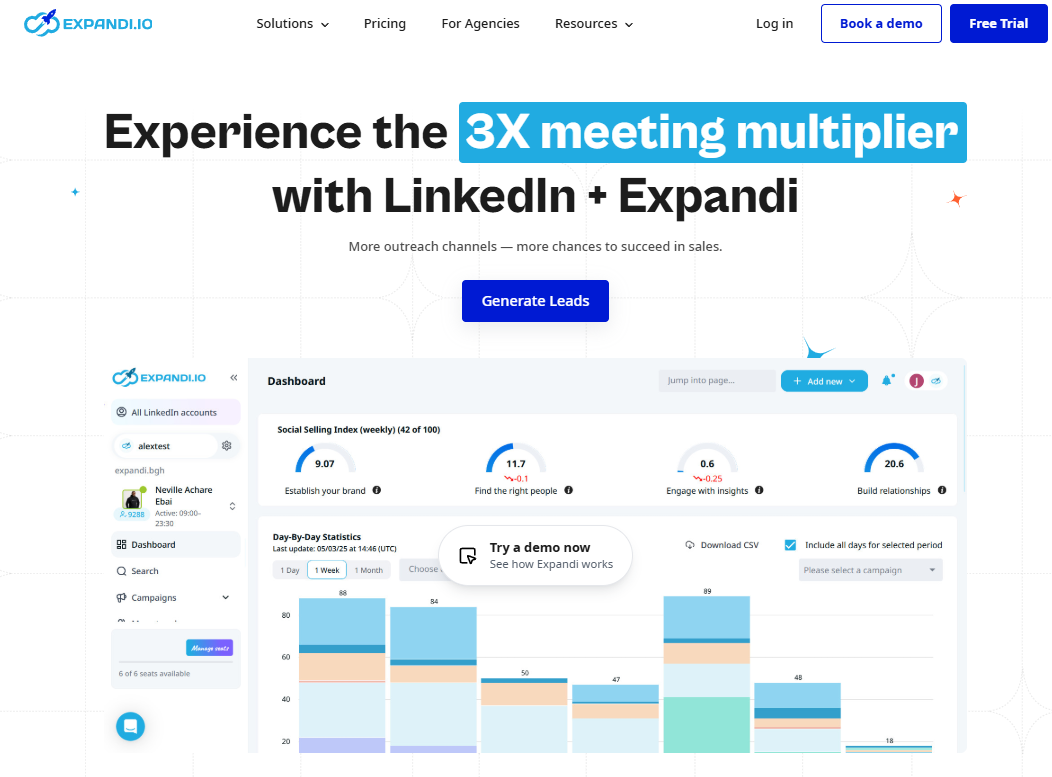
Expandi is an advanced LinkedIn automation platform focused on hyper-personalized outreach, providing custom messaging options, dynamic media integration, and multi-channel campaign support.
Key Features:
- Personalized LinkedIn campaigns
- Dynamic messaging (images, GIFs)
- Dedicated IP and analytics
Pros:
- Highly personalized outreach with custom fields, images, and GIFs.
- Seamless multi-channel integration with email.
- Dedicated IP for increased account safety.
- Detailed analytics and advanced campaign controls.
Cons:
- Limited beyond LinkedIn and email outreach.
- Overly feature-rich for simpler needs.
- No built-in lead sourcing outside LinkedIn.
- Relatively high pricing.
Pricing: Typically $99/month (discounted to ~$79/month annually).
3. Apollo.io
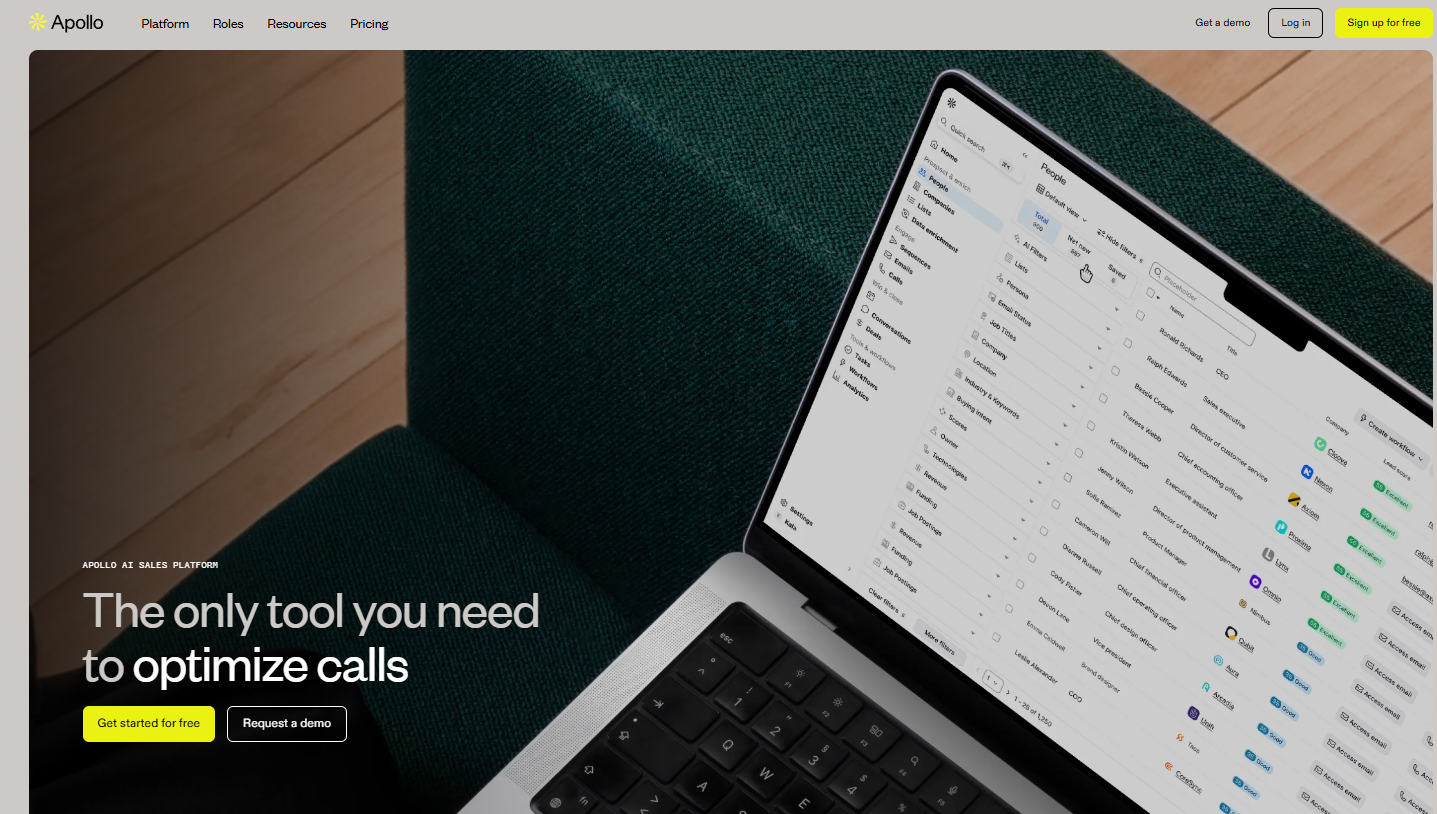
Apollo is an all-in-one sales intelligence and outreach platform combining a vast lead database with powerful multi-channel outreach capabilities. It's ideal for sales teams looking to streamline prospecting, email campaigns, and analytics under one roof. Apollo leverages AI-driven insights to suggest high-quality leads, optimize outreach timing, and automate personalized email content, significantly improving engagement rates.
Key Features:
- AI lead recommendations
- Email and multi-channel outreach
- Powerful analytics
Pros:
- Combines multiple functions, reducing tool-switching.
- AI-enhanced suggestions for leads and emails.
- Robust analytics and A/B testing.
- Free basic tier available.
Cons:
- Feature-rich but can be complex for new users.
- Varying quality of contact data.
- UI can feel overwhelming.
- Primarily focused on B2B.
Pricing: Free basic tier; Paid plans start at $49/user/month (annual billing). Advanced tiers range from $99 to $149/user/month.
4. Instantly
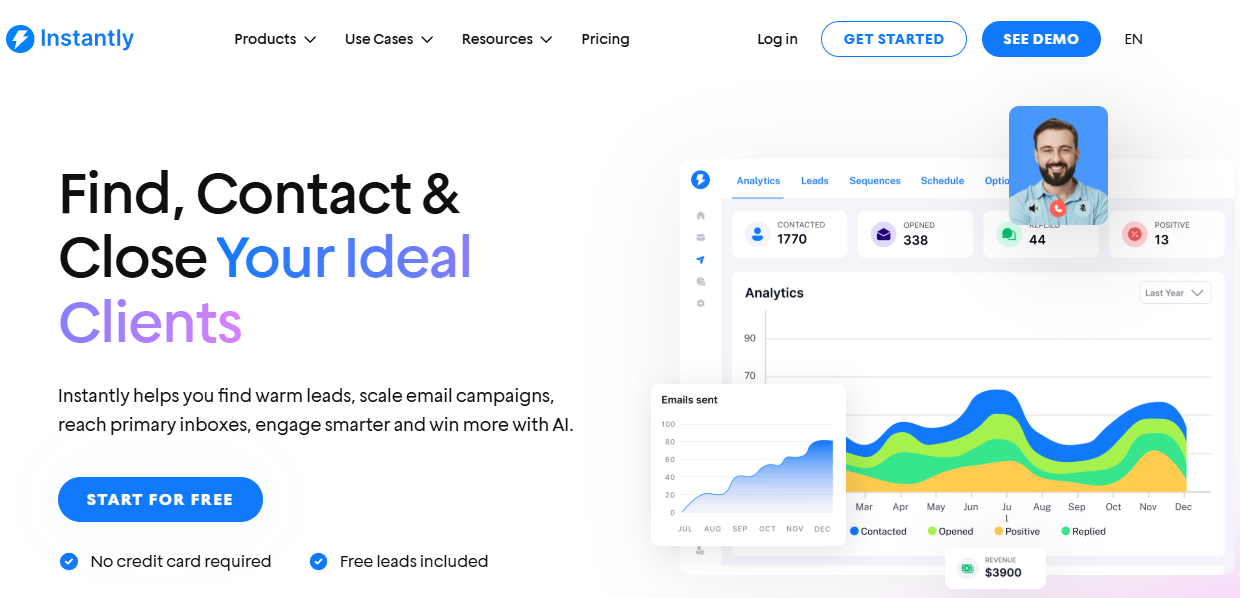
Instantly specializes in scalable cold email outreach, ideal for SDRs and founders needing high-volume personalized campaigns that reliably land in inboxes. With advanced AI email writing and robust deliverability tools like inbox rotation and automated warm-up, Instantly boosts email reputation and engagement effortlessly.
Key Features:
- Scalable email campaigns
- AI email writing
- Inbox rotation and warming
Pros:
- Excellent deliverability with automatic inbox warm-up.
- AI-driven email personalization saves time.
- Simple, intuitive interface.
- Supports multiple sender accounts for scalability.
Cons:
- Limited to email outreach; no built-in CRM or additional channels.
- Basic reporting, less detailed than some larger platforms.
- Complex scenarios may need manual personalization.
Pricing: Starts around $30/month for basic unlimited sends; higher tiers (~$80/month) offer more sending accounts and team features. No free tier, but a free trial is often available.
5. Lemlist

Lemlist is a multichannel outreach platform with a strong emphasis on personalized and engaging communications via email and LinkedIn. It stands out with dynamic, personalized images and videos, and AI-driven ice-breaker suggestions based on LinkedIn activity. Lemlist helps sales reps build and automate engaging outreach sequences that boost reply rates.
Key Features:
- Personalized images/videos
- AI-driven personalization
- Multichannel sequences
Pros:
- Multichannel outreach (email, LinkedIn, calls) in a single sequence.
- Innovative personalization with dynamic images and videos.
- Strong community and rich template library.
- Effective email deliverability tools, including AI-driven warm-up.
Cons:
- Playful UI may not appeal to all users, particularly in more formal environments.
- Dependence on LinkedIn policies could require adjustments.
- Higher per-user costs compared to some email-only tools.
- Lacks comprehensive CRM capabilities.
Pricing: Email-only plan around $59/user/month; Multichannel plan around $99/user/month (annual billing). Free Chrome extension available for basic lead scraping.
CRM & Pipeline Management
Once leads are generated, CRM and pipeline management tools play a crucial role in tracking, nurturing, and converting them into closed deals. These tools help sales teams stay organized, automate repetitive tasks, and provide insights into deal progress. Here’s a breakdown of three top CRM solutions catering to different business needs.
6. Salesforce Sales Cloud

Salesforce remains a powerhouse CRM, known for its deep customization, extensive automation, and AI-driven insights. It’s widely used by enterprises and growing businesses looking for a robust, scalable solution.
Key Features:
- AI-Powered Insights: Leverages Einstein AI to provide predictive analytics and lead scoring.
- Advanced Automation: Automates workflows, email sequences, and task management.
- Extensive Customization: Offers customizable dashboards, reports, and integrations with third-party apps.
- Comprehensive Integrations: Connects seamlessly with marketing tools, analytics software, and ERP systems.
Best For:
- Large enterprises and mid-sized businesses requiring extensive customization and scalability.
- Companies that need deep sales automation and AI-driven insights.
- Organizations already using Salesforce’s ecosystem (Marketing Cloud, Service Cloud, etc.).
Pros:
- Highly customizable and scalable.
- Powerful automation and reporting tools.
- Strong integration ecosystem.
Cons:
- Can be complex to set up and manage.
- High pricing may be a barrier for small teams.
Pricing:
- Essentials: $25/user/month
- Professional: $75/user/month
- Enterprise: $150/user/month
- Unlimited: $300/user/month
7. HubSpot Sales Hub

HubSpot offers an intuitive and feature-rich CRM designed for small and mid-sized businesses. It integrates seamlessly with marketing, customer service, and content management tools, making it a great all-in-one platform.
Key Features:
- Seamless Marketing & Sales Integration: CRM syncs with email marketing, automation, and customer service.
- Pipeline & Deal Tracking: Visual sales pipeline to track progress.
- Email Automation & Personalization: Automate outreach while keeping a personal touch.
- Live Chat & Meeting Scheduling: Engage leads in real-time and simplify scheduling.
Best For:
- Small to medium-sized businesses seeking an easy-to-use, all-in-one CRM.
- Teams looking for built-in marketing and automation features.
- Companies needing a free CRM with upgrade options as they scale.
Pros:
- User-friendly and quick to implement.
- Strong sales and marketing automation.
- Free version available with essential CRM features.
Cons:
- Advanced features and automation can become costly.
- Limited customization compared to Salesforce.
Pricing:
- Free Basic Version
- Starter: ~$20/user/month
- Professional: $500/month (5 users)
- Enterprise: $1,200/month (10 users)
8. Pipedrive
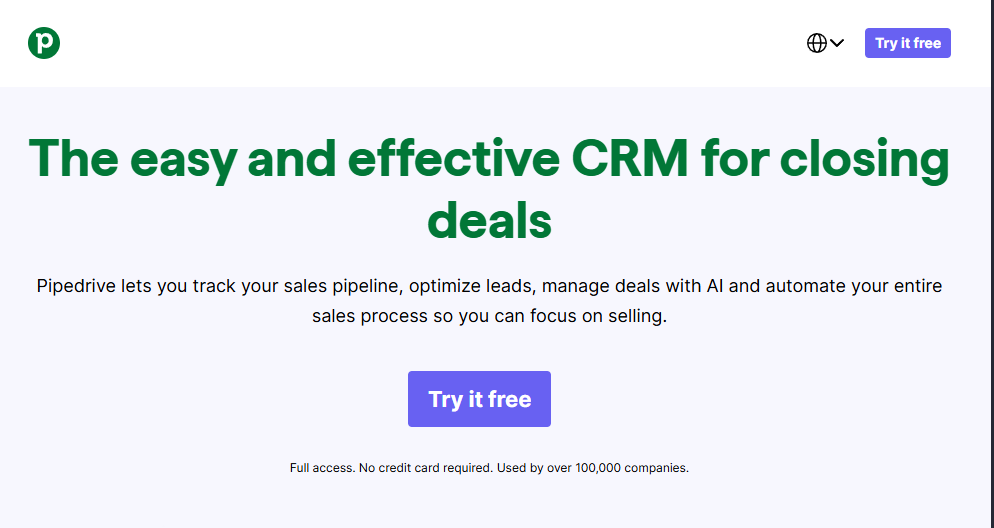
Pipedrive is a straightforward, visually intuitive CRM focusing on pipeline management. Its drag-and-drop functionality makes it easy for small and mid-sized teams to track deals efficiently.
Key Features:
- Visual Sales Pipeline: Drag-and-drop interface for easy deal tracking.
- Sales Automation: Automate follow-ups, lead assignments, and deal progress.
- Customizable Reports & Insights: Track sales performance and identify bottlenecks.
- Email & Communication Tracking: Syncs with email for streamlined sales interactions.
Best For:
- Small to midsize teams looking for a simple and effective CRM.
- Sales teams needing an intuitive and quick-to-learn platform.
- Businesses wanting an affordable CRM with essential automation.
Pros:
- Easy to use with a clean, visual interface.
- Affordable pricing with essential sales automation.
- Quick setup with minimal learning curve.
Cons:
- Limited advanced AI and automation compared to Salesforce and HubSpot.
- Simpler reporting capabilities.
Pricing:
- Essential: $15/user/month
- Advanced: $29/user/month
- Professional: $59/user/month
- Enterprise: $99/user/month
Intelligence & Forecasting
This category is all about sales intelligence, finding and enriching lead data, gaining insights into deals, and forecasting revenue. The tools in this space help answer critical sales questions:
- Who should we call next?
- What are they interested in?
- Which deals are likely to slip?
For sales leaders, this is the ultimate command center. Below are three top tools that elevate forecasting and deal intelligence.
9. ZoomInfo SalesOS
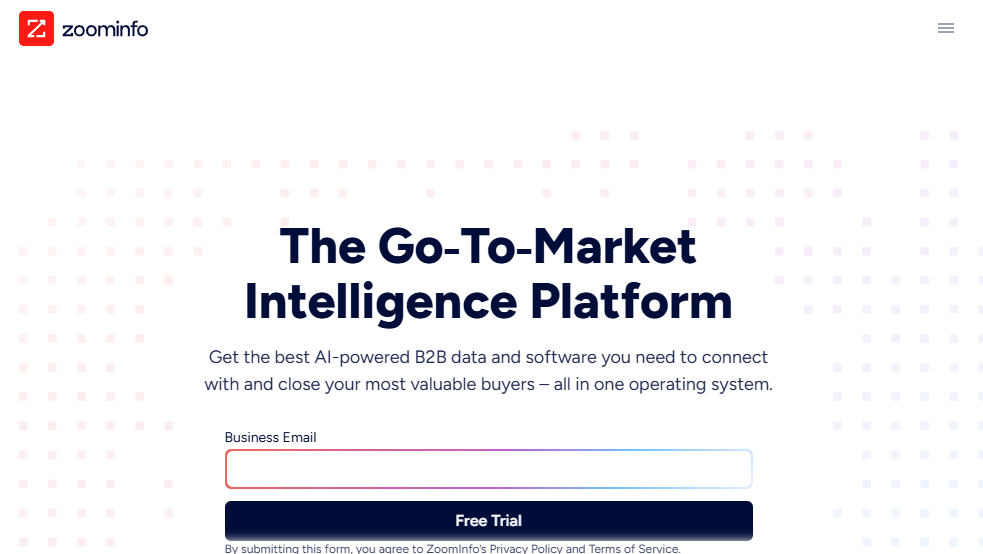
ZoomInfo is the heavyweight champion of B2B sales intelligence, providing an extensive database of business contacts, firmographics, and buying intent signals. If Apollo is the all-in-one scrappy option, ZoomInfo is the enterprise-grade data powerhouse.
Key Features:
- Contact & Company Data: Access millions of direct dials, emails, org charts, and firmographics.
- Intent Data: Identify companies researching your product and engage when interest peaks.
- AI Enrichment: Automatically update CRM with verified contact details.
- Seamless Integrations: Sync with CRMs and sales platforms for one-click data exports.
Best For:
- Teams doing high-volume outbound or account-based sales.
- Companies prioritizing reliable contact data and sales intelligence.
- Organizations investing in intent-based prospecting.
Pros:
- Comprehensive and up-to-date B2B database.
- Advanced filtering for hyper-targeted prospecting.
- Automates data enrichment and integrates with CRMs.
Cons:
- Premium pricing; often requires a yearly contract.
- Occasional outdated or incorrect data—verification still required.
Pricing: Pricing is custom, but small-team plans typically start at $15,000/year, scaling up based on features and seats.
10. Gong
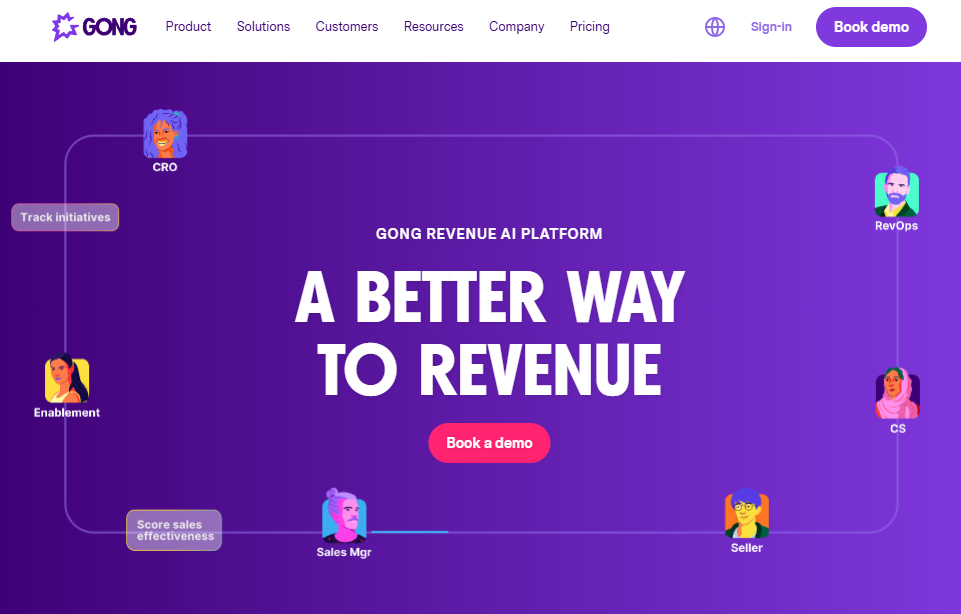
Gong is the leader in conversation intelligence, analyzing sales calls, emails, and meetings to extract actionable insights. It acts as an AI-powered sales coach, helping teams refine their pitch, improve engagement, and forecast deal success.
Key Features:
- Call & Email Analysis: AI breaks down talk ratios, key topics, objections, and deal risks.
- Deal Intelligence: Tracks engagement trends to flag at-risk deals.
- Coaching & Benchmarking: Provides data-driven feedback to improve sales performance.
- Pipeline Visibility: Shows which deals have momentum and which need attention.
Best For:
- Sales teams focused on call-heavy outbound strategies.
- Managers looking to improve coaching and deal execution.
- Companies wanting AI-powered forecasting based on real customer conversations.
Pros:
- AI-driven insights help reps refine their pitch.
- Forecasting based on real interactions, not gut feel.
- Helps new reps ramp up faster by learning from top performers.
Cons:
- Primarily optimized for calls and meetings—less impact for email-heavy sales teams.
- Expensive, typically priced per seat.
Pricing: Estimated at $100+/user/month, with mid-sized teams investing $30,000–$50,000/year.
11. Clari
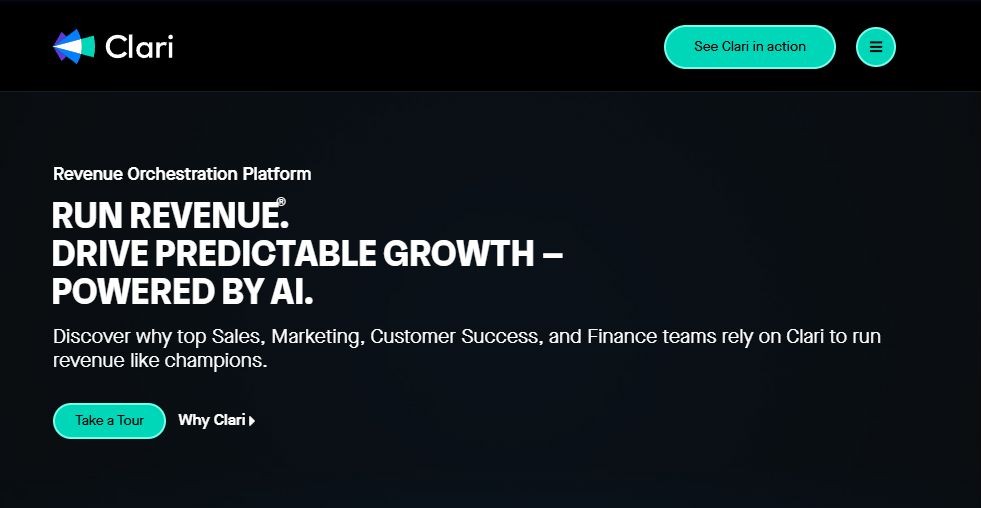
Clari specializes in revenue forecasting and pipeline management, turning CRM, email, and meeting data into predictive insights. It helps sales leaders call accurate forecasts while proactively flagging deal risks.
Key Features:
- AI-Powered Forecasting: Predicts deal success based on engagement, CRM activity, and trends.
- Pipeline Inspection: Highlights deals at risk of slipping with red/yellow/green status indicators.
- Automated Deal Nudges: Triggers reminders when key deal milestones are missed.
- Scenario Planning: Model revenue impact if deals shift to the next quarter.
Best For:
- Mid-to-large sales teams needing data-driven forecasting.
- Revenue leaders looking for objective, AI-enhanced deal insights.
- Companies tired of spreadsheet-based forecasting.
Pros:
- More accurate forecasts than human judgment alone.
- Provides early warnings on deals losing momentum.
- Reduces reliance on manual CRM updates by capturing real sales activity.
Cons:
- Overkill for small teams with simple pipelines.
- Forecast quality depends on CRM data hygiene.
Pricing: Custom pricing, often $50,000–$100,000/year for mid-sized deployments.
Communication & Engagement
Sales engagement tools help teams connect with prospects across multiple channels: email, phone, SMS, and social, while ensuring every touchpoint is coordinated. Unlike standalone email tools (covered in the Outreach category), these platforms orchestrate outreach sequences, automate follow-ups, and provide insights to prevent leads from slipping through the cracks.
Here’s a look at two leading solutions in this space:
12. Outreach.io
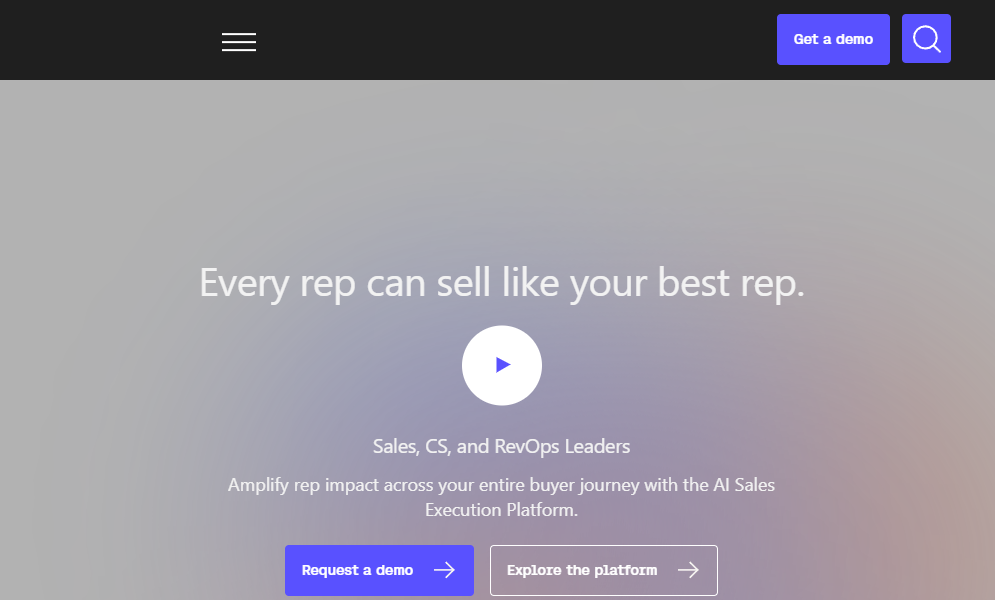
Outreach is a top-tier sales engagement platform that helps reps build and execute multi-channel sequences at scale. Beyond email automation, it syncs calls, LinkedIn touches, and SMS follow-ups, serving as the daily command center for sales teams.
Key Features:
- True Multi-Channel Engagement: Email, phone, LinkedIn, and SMS in one dashboard.
- Massive Productivity Gains: Automates dialing, email templates, and task management.
- Robust Analytics & A/B Testing: Refines sequences for higher reply rates.
- AI-Powered Automation: Automates prospecting, lead scoring, and email personalization.
Pros:
- Multi-channel engagement in a single platform.
- Significant productivity improvements through automation.
- Strong analytics and A/B testing to optimize outreach.
- AI-driven features for smarter prospecting and personalization.
Cons:
- Complex implementation, requiring onboarding and admin support for larger teams.
- High cost, ideal for scaling teams but pricey for individuals.
- Steep learning curve due to the feature-rich interface.
- CRM syncing issues if data hygiene is not maintained.
Pricing: Typically $100–$150/user/month, with minimum seat requirements.
13. Salesloft
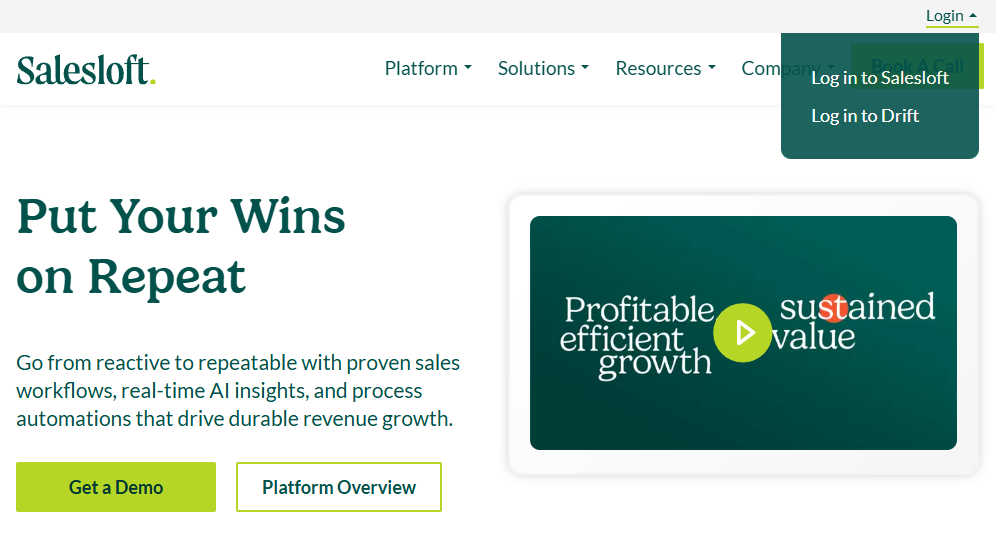
Salesloft is a leader in sales engagement, offering powerful cadences, a built-in dialer, and CRM-friendly workflows. Often compared to Outreach, it shines with its deep Salesforce integration and intuitive coaching tools.
Key Features
- Workflow Optimization: AI-powered guidance to keep reps on track.
- Multi-Channel Outreach: Built-in dialer, SMS, and email tracking.
- Seamless Salesforce Integration: Native integration with Salesforce for smooth data syncing.
- Collaboration-Friendly: Easily share cadences, scripts, and coaching insights.
Pros
- AI-driven workflow optimization.
- Multi-channel outreach (dialer, SMS, and email tracking).
- Native Salesforce integration for easier data syncing.
- Simple collaboration on cadences, scripts, and insights.
Cons
- Overkill for small teams with simpler sales processes.
- Steep learning curve, though some find it more intuitive than Outreach.
- New AI features still evolving and not as advanced as Gong or Clari.
- Premium pricing, similar to Outreach, making it a significant investment.
Pricing: Typically from $75/user/month, with annual packages available. Plans range from Essentials ($1,250 per user/year) to Elite, which includes AI-driven insights at higher tiers.
Marketing Integrations
Marketing and sales work best when seamlessly connected. These tools ensure leads flow smoothly between teams while automating key processes—no more manual CSV imports!
14. Marketo (Adobe Marketing Cloud)

Marketo automates lead capture, nurturing, and scoring before handing off prospects to sales teams. Integrated with CRMs, it tracks engagement (emails, web visits, downloads) and triggers sales alerts when leads hit key thresholds. Its deep integration with Adobe’s analytics provides even richer insights into prospects.
Key Features:
- Smart Lead Scoring: Ensures sales only engage with warm leads.
- Custom Triggers: Automates CRM tasks and sales alerts.
- Enterprise Scalability: Handles large databases effectively.
Pros:
- Smart lead scoring prioritizes warm leads for sales.
- Custom triggers for task automation and alerts.
- Scalable for large enterprises with complex databases.
Cons:
- Primarily for marketing teams; sales teams rarely log in.
- Expensive and complex, requiring admin support.
- Overkill for small businesses; simpler tools like HubSpot may be more suitable.
Pricing: Marketo starts at $1,500–$2,000/month for SMBs and scales to tens of thousands per year for enterprises. For companies already using Marketo, ensure you’re leveraging its sales features; otherwise, HubSpot or Pardot might be better alternatives.
15. Zapier
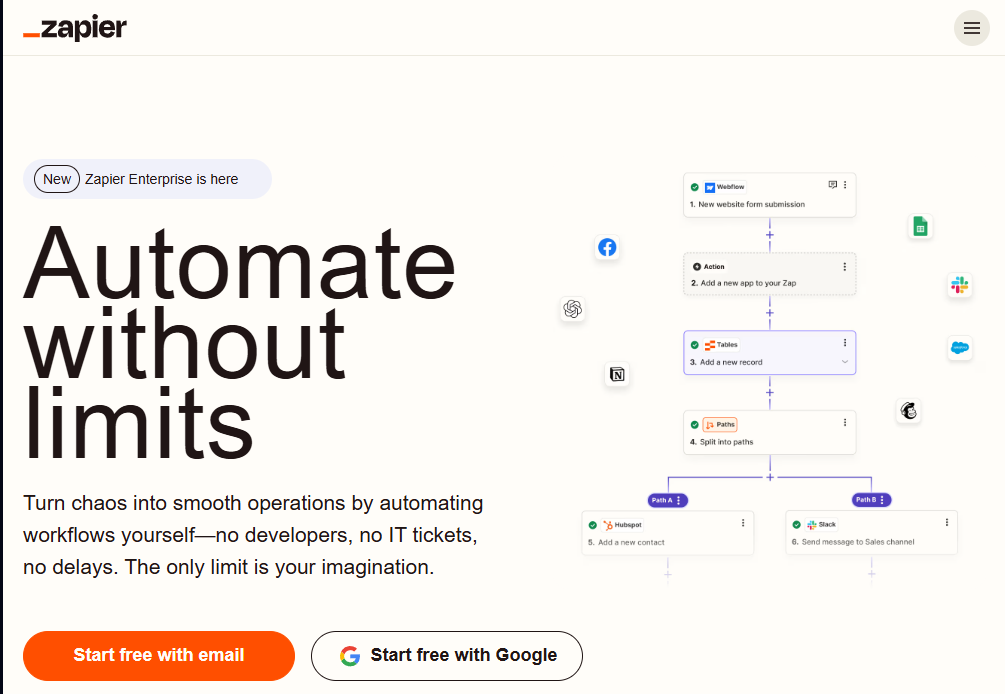
Zapier automates workflows by connecting 5,000+ apps without needing coding skills. It streamlines sales tasks like syncing leads from web forms to CRMs, updating spreadsheets, and sending instant Slack alerts. With its expanded AI capabilities including OpenAI-powered data transformation, Zapier offers even more automation potential.
Key Features:
No-Code Automation: Set up workflows in minutes, no IT required.
Massive Integrations: Connects with nearly any tool.
Flexible Workflows: Supports multi-step, conditional logic.
Pros:
- No-code automation makes it easy to set up.
- Huge integration library connects with nearly any app.
- Flexible workflows support multi-step automation.
Cons:
- Lower-tier plans may experience delays in real-time processing.
- Large workflows can become difficult to manage.
- Costs increase with usage, making it less ideal for high-volume users.
Pricing:Zapier offers a free tier (100 tasks/month). Paid plans start at $20/month for 750 tasks, with Pro at $49/month for 2,000 tasks and higher enterprise options available.
16. ActiveCampaign

ActiveCampaign combines email marketing, automation, and a built-in CRM, making it ideal for small to mid-sized businesses needing more than Mailchimp but less than enterprise tools. It automates marketing sequences, routes engaged leads to sales, and integrates with external CRMs if needed.
Key Features:
- Marketing Automation: Visual workflow builder for drip campaigns, segmentation, and triggers.
- CRM & Sales Automation: Built-in deal tracking, lead scoring, and pipeline management.
- AI Enhancements: Predictive email sending and AI-generated email content.
- Multi-Channel Messaging: Email, SMS, site messages, and social integrations.
- Reporting & Analytics: Basic performance tracking with deeper insights in higher plans.
- Integrations: Syncs with tools like Salesforce, HubSpot, and Shopify.
Pros:
- User-friendly automation builder with advanced segmentation.
- All-in-one platform for email marketing, sales, and customer management.
- Cost-effective compared to separate marketing automation and CRM solutions.
Cons:
- CRM lacks advanced sales features for large teams.
- Interface can feel cluttered as features expand.
- Advanced tools like lead scoring require higher-tier plans.
Pricing:
Starts around $70/month for 5,000 contacts (Lite plan, email-only) and $125/month for Plus (includes CRM and automation). Ideal for businesses needing both marketing automation and a basic CRM at an affordable rate.
Video/Voice/Scheduling
Sales isn’t just emails and CRMs – you’ve got calls to make, meetings to book, and increasingly, videos to send. This category covers tools for video messaging, voice calling systems, and meeting scheduling.
These tools ensure you can communicate effectively (and conveniently) with prospects and clients, whether face-to-face (via video), voice-to-voice, or calendar-to-calendar.
17. Calendly
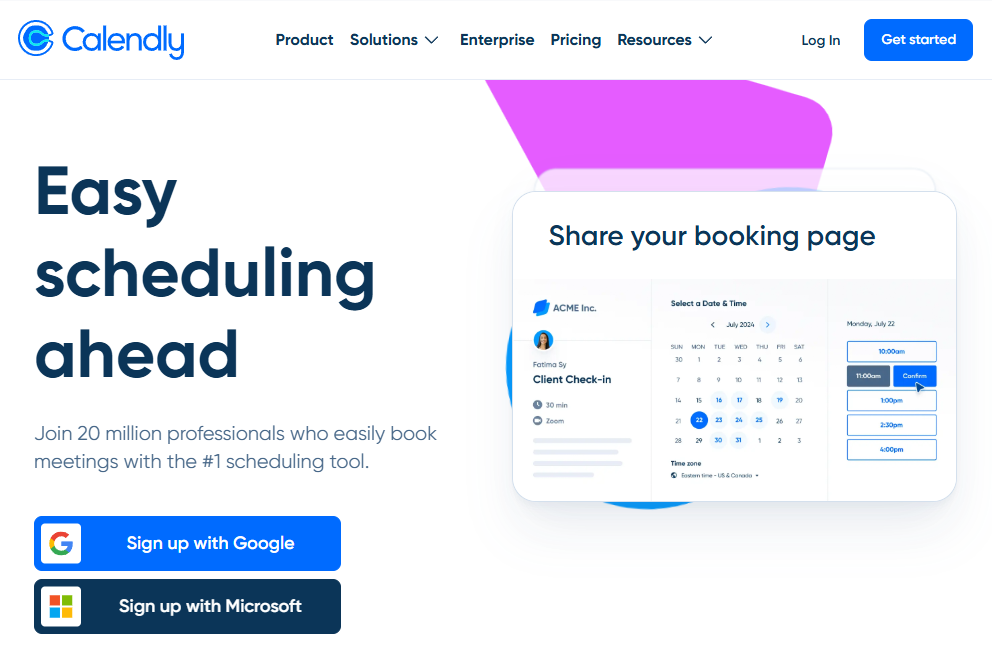
Calendly automates meeting scheduling by allowing users to send a link for others to choose a convenient time, eliminating back-and-forth emails. Ideal for sales teams, it simplifies scheduling and integrates seamlessly with calendars and video conferencing tools. It also has features like round-robin assignments and workflows, making it a top choice for efficient scheduling.
Key Features:
- Automated Scheduling: Handle time zones, availability, and calendar invites automatically.
- Customizable Event Types: Create various meeting types (e.g., 15-min intro, 30-min demo) with different rules.
- Team Features: Round-robin meeting assignments, group meetings, and collective scheduling for multi-party calls.
- Integrations: Syncs with Google/Outlook calendars, CRMs, and video conferencing (Zoom/Teams).
- Workflows: Set up reminder emails and follow-up tasks.
Pros:
- Easy scheduling: Automatically handles time zones, availability, and calendar invites.
- Multiple event types: Set up different meeting lengths (e.g., 15-min intro, 30-min demo) with specific rules.
- Team features: Round-robin meeting distribution, group meetings, and collective scheduling for coordinating multi-party calls.
- Wide integrations: Syncs with Google/Outlook calendars, CRMs, and video conferencing tools (auto-creates Zoom/Teams links).
Cons:
- If prospects also use Calendly, you might end up with dueling links—pro tip: let the seller accommodate the buyer’s scheduling preferences.
- Limited customization for the booking page unless on the enterprise plan.
- Complex schedules with many dependencies may not be fully supported—best for simpler use cases.
- Free plan is basic—most businesses will need the Professional plan for full functionality.
Pricing:
- Free: Basic functionality for individuals.
- Essentials: ~$10/user/month for more event types and calendar connects.
- Professional: ~$15/user/month, includes SMS notifications, integrations, and branding options.
- Teams: ~$16/user/month, adds round-robin and team features.
- Enterprise: Custom pricing, with advanced security and SSO.
For a small team, expect to pay $12–$15 per rep/month, which can easily pay for itself by preventing missed meetings due to scheduling delays. Alternative tools like Chili Piper and x.ai exist, but Calendly’s ubiquity remains its main strength.
18. Chili Piper
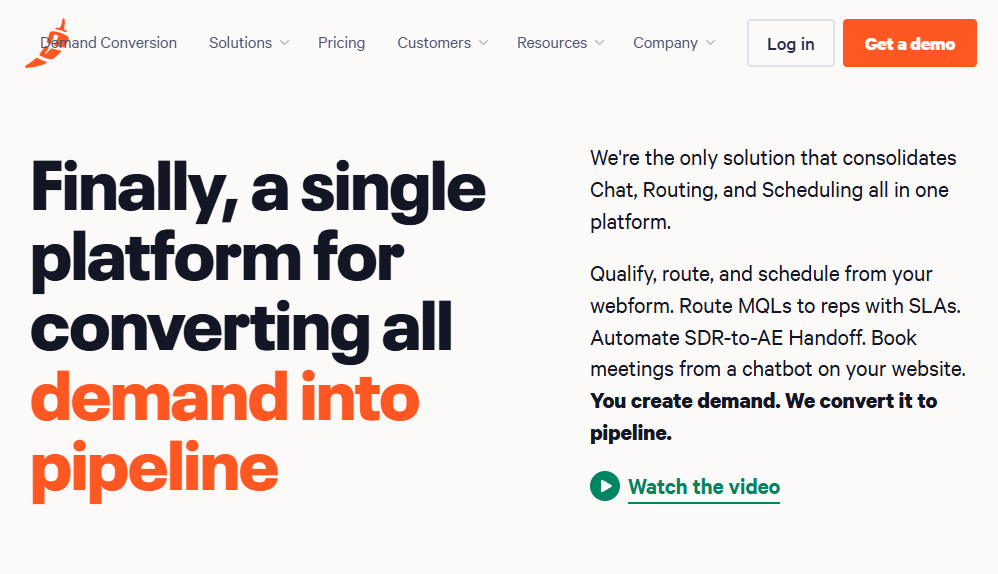
Chili Piper is a scheduling tool designed for inbound lead conversion, allowing leads to book meetings instantly after filling out a form—eliminating the waiting time. It excels in advanced routing, directing meetings based on criteria like territory, account owner, or round-robin logic. This year, it expanded into a Buyer Enablement platform with features like chat handoffs and qualifying questions before scheduling.
Key Features:
- Instant Booking: Allows leads to book a meeting immediately after form submission, boosting conversion rates.
- Advanced Routing: Automatically assigns meetings based on territory, account type, or other rules.
- CRM Integration: Seamlessly integrates with Salesforce, HubSpot, and Marketo forms.
- Booking on Behalf: Enables reps to schedule meetings for others (e.g., specialists) without back-and-forth.
Pros:
- Increases inbound conversion by letting hot leads book instantly.
- Advanced routing for tailored lead assignment.
- CRM and form integration for seamless workflow.
Cons:
- Setup is more complex, requiring CRM integration and routing configuration.
- Higher pricing than basic tools like Calendly.
- UI less polished than Calendly, often appearing as a widget after a form.
Pricing: Starts at around $30/user/month for the Form Concierge product and $15/user/month for Instant Booker, with additional platform fees based on lead volume. Ideal for midsize companies with high inbound lead volumes.
19. Vidyard
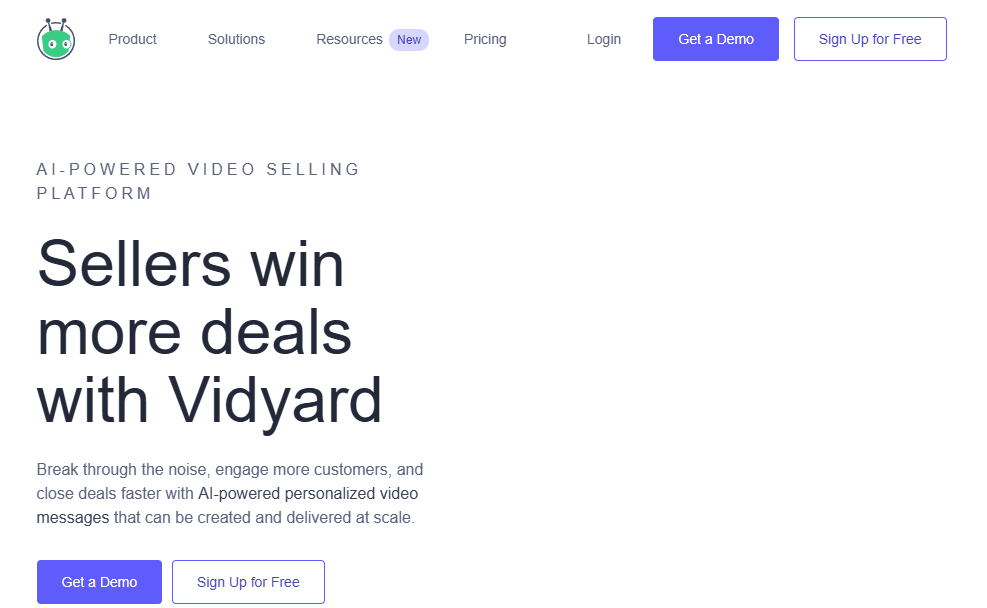
Vidyard is a video messaging and hosting platform designed for sales and marketing teams. It allows you to record personalized video introductions, demos, and proposal walk-throughs, and send them via tracked links or email embeds. Vidyard added AI-driven features like an “AI Video Sales Agent” for automating personalized video creation and AI avatars to deliver scripted messages. It’s perfect for engaging prospects with 1-to-1 videos and tracking viewer interest through analytics.
Key Features:
- Personalized Videos: Record quick, engaging videos to enhance outreach and follow-ups.
- Analytics: Track who watched your video, for how long, and get real-time alerts for high engagement signals.
- Scalable Library: Reuse videos for common messages while adding personalized intros. AI Automation: Automate parts of video creation while maintaining a personal touch at scale.
Pros:
- Increases engagement with more personal, face-to-face outreach.
- Easy to use with a browser extension and instant video uploads.
- Analytics help gauge prospect interest and prioritize follow-ups.
Cons:
- Some reps may feel uncomfortable on camera and need training.
- Click-through required to watch videos, which may discourage some prospects.
- Higher pricing for business features like CTAs and CRM integrations.
Pricing:
- Free: Limited features with watermark.
- Starter: ~$59/seat/month.
- Teams/Business: Custom pricing based on user count and features, often around $300–$1000+/month.
20. Aircall
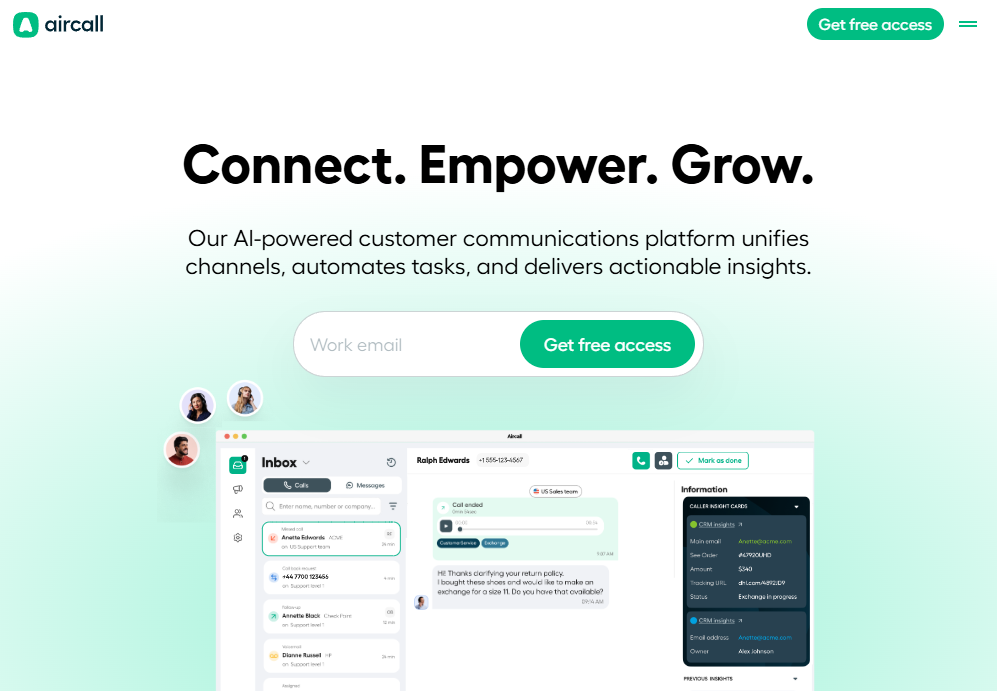
Aircall is a cloud-based phone system (VoIP) designed for sales and support teams. It enables team members to make and receive calls, share phone numbers, record calls, and integrate call data with CRM systems.
It’s ideal for sales teams that rely heavily on phone interactions like cold calls and demos, especially in remote environments. By this year, Aircall added AI-driven features like transcription and insights, enhancing team productivity.
Key Features:
- Quick Deployment: No hardware required, set up and start calling immediately.
- Shared Visibility: See when teammates are on calls, coach them in real time, and transfer calls easily.
- CRM Integration: Automatically log calls in systems like Salesforce or HubSpot, reducing manual data entry.
- Analytics: Track call volume, duration, and other metrics to manage team performance.
Pros:
- Easy to deploy for new reps.
- Shared visibility for efficient team selling and handoff.
- CRM integration automates data logging and enhances workflows.
- Call recording and analytics improve training and team management.
Cons:
- Paid system – more suited for teams than solo operators.
- Costs scale with usage, especially for outbound calls and phone numbers.
- Dependent on internet quality for call reliability.
Pricing:
- Essentials: ~$30/user/month
- Professional: ~$50/user/month
- Additional fees for local/toll-free numbers (~$6 each).
Social Automation Tools for Sales
Social automation tools are key for salespeople leveraging platforms like LinkedIn for B2B outreach. These tools automate routine actions, keeping you engaged with prospects at scale while adhering to platform rules to avoid spammy practices. Here are the top tools this year.
21. LeadPlay.io (LinkedIn + Email Automation)
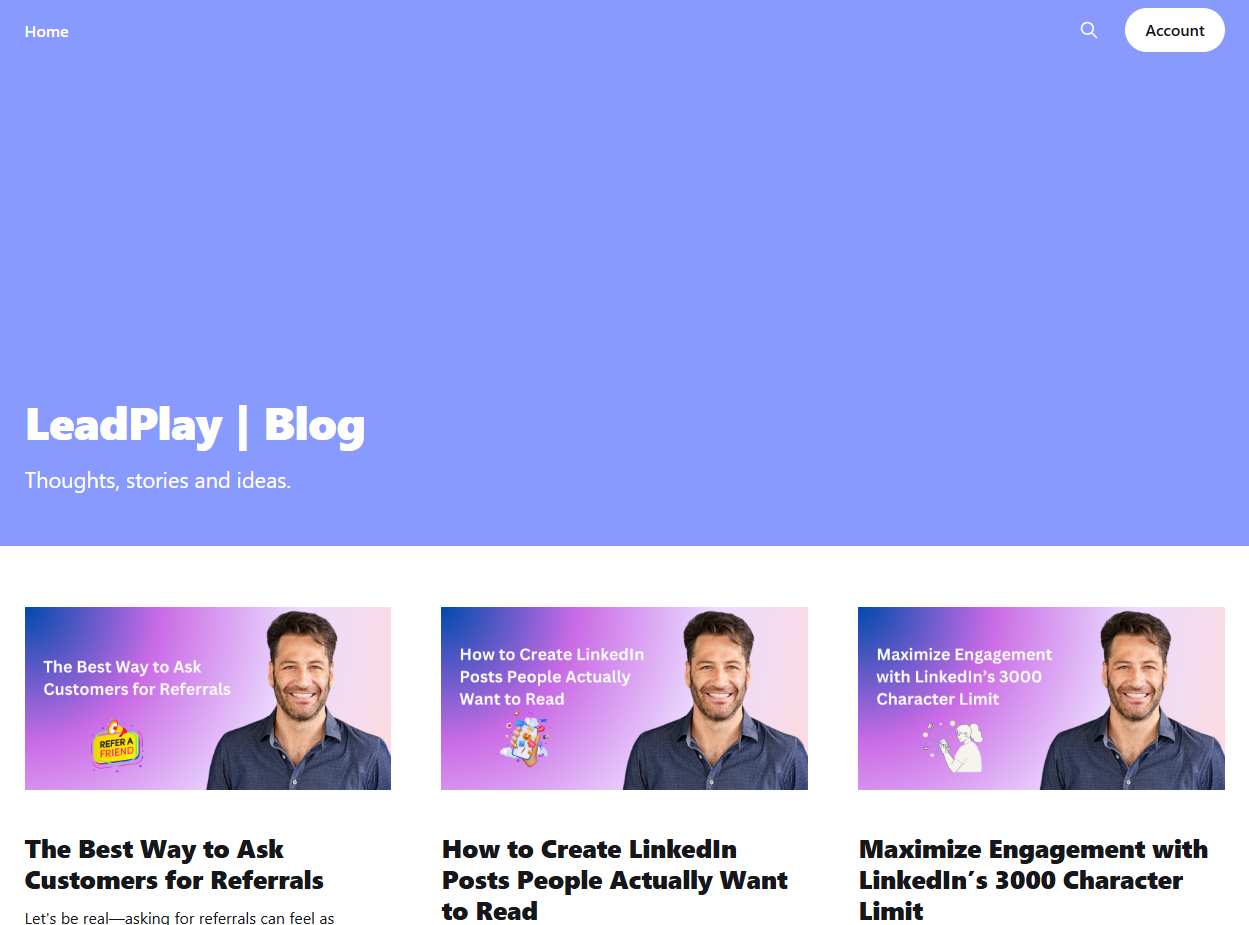
LeadPlay automates LinkedIn actions like connection requests, profile visits, and follow-ups, mimicking human behavior to avoid flags. It integrates with LinkedIn Sales Navigator for efficient prospecting. LeadPlay allows you to send up to 200 connection requests a day safely and nurture leads over time without manual input.
Pricing: $39-$79/month.
22. Expandi

Expandi is another LinkedIn automation tool that emphasizes personalization with dynamic GIFs and images. It runs complex campaigns like auto-sending personalized connection requests and follow-ups. Expandi also interacts with posts to boost engagement.
Pricing: $99/month.
23. PhantomBuster
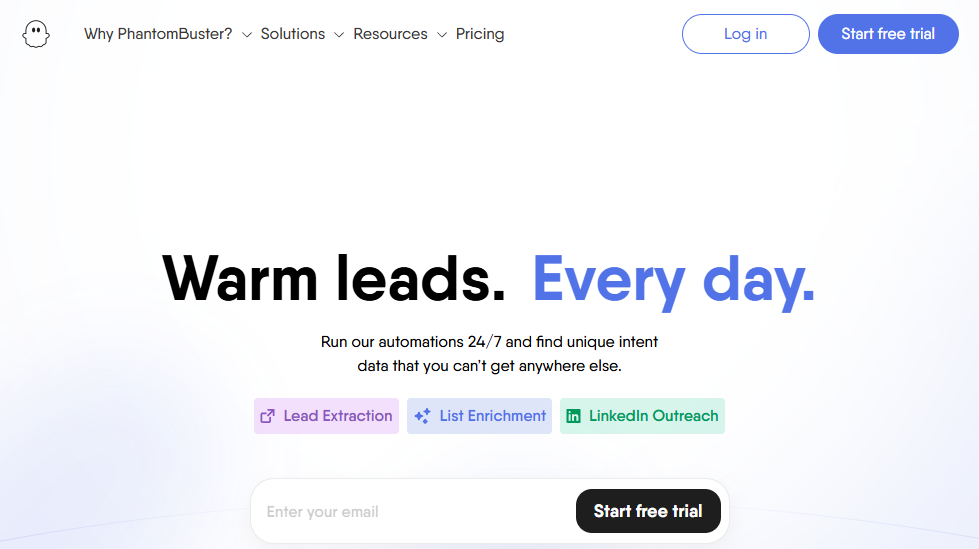
PhantomBuster is a versatile tool for automating tasks across platforms like LinkedIn, Twitter, and Instagram. It offers pre-made scripts (aka “Phantoms”) for profile visits, data scraping, and connection requests. Ideal for tech-savvy users who want to automate without building from scratch.
Key Features:
- Pre-built automation scripts for LinkedIn, Twitter, Instagram, and more
- Web data scraping capabilities without coding
- Chain multiple Phantoms together for complex workflows
- Cloud-based execution (no need to leave your browser open)
- API access for developers
Pros:
- Highly flexible and customizable
- Saves significant manual effort, especially for lead generation and outreach
Cons:
- Requires technical knowledge to unlock full potential
- Risk of triggering spam filters or account restrictions if not used carefully
Pricing:
- Starts at $59/month
Social Scheduling Tools
Whether you're a solo rep building your personal brand or a team coordinating multi-platform campaigns, scheduling tools ensure you show up when it matters most—without sacrificing time better spent closing deals.These tools stand out for this.
24. Buffer
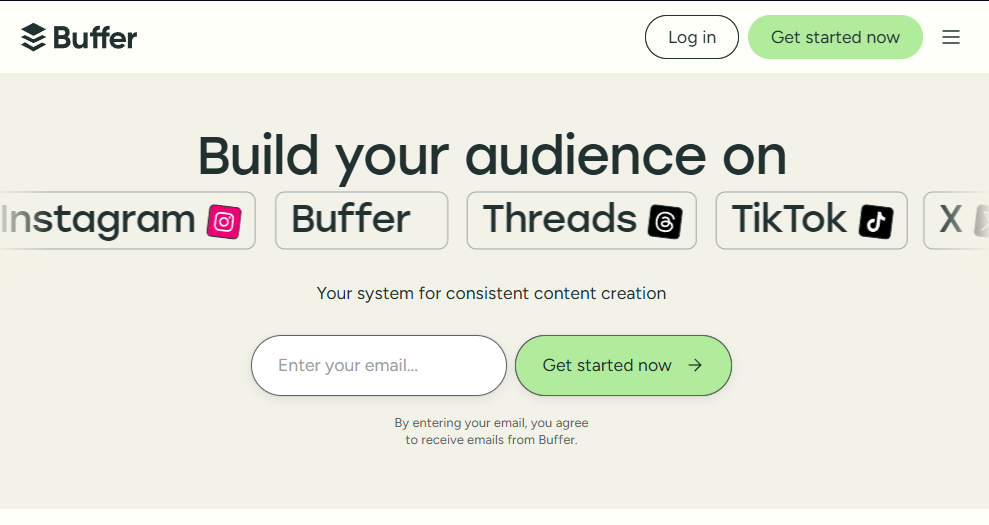
Buffer is a streamlined, user-friendly tool that helps individuals and small teams schedule social media posts, analyze engagement, and stay consistent without logging in daily. It’s ideal for solo sales reps or startups who want to stay active online with minimal fuss.
Key Features:
- Easy-to-use post scheduler across LinkedIn, Twitter, Instagram, and more
- Post performance analytics (clicks, likes, engagement)
- Content calendar view to plan ahead
- AI-assisted post writing and repurposing
- Team collaboration (in higher plans)
Pros:
- Super simple and intuitive—minimal learning curve
- Helps maintain visibility without daily effort
- Affordable for individuals and small teams
Cons:
- Lacks advanced features for large teams or enterprise use
- Limited keyword or hashtag tracking
- No built-in engagement features (e.g., replying to comments from dashboard)
Pricing:
- Free Plan: Basic tools for individuals
- Essentials: $15/month
- Team and Agency Plans: $30–$100+/month depending on users and features
25. Hootsuite
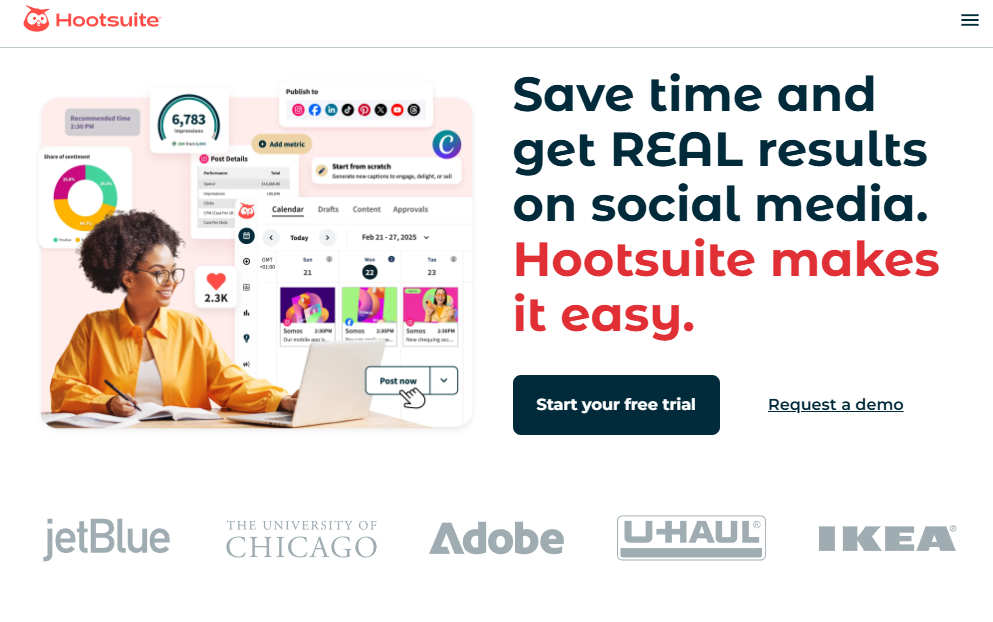
Hootsuite is a robust social media management platform geared toward larger teams and organizations. Beyond scheduling, it offers in-depth analytics, social listening, and customer engagement tools—great for sales teams focused on building brand presence and prospecting.
Key Features:
- Multi-platform post scheduling with calendar management
- Keyword and hashtag monitoring for lead discovery
- Advanced analytics and ROI tracking
- Unified inbox to reply to messages across platforms
- Team permissions and approval workflows
Pros:
- Great for teams that need advanced scheduling + monitoring
- Helps discover potential leads through social listening
- Centralized dashboard for managing multiple accounts
Cons:
- Can be overkill for solo reps or small teams
- More focused on brand and content marketing than direct sales
- Higher learning curve and cost
Pricing:
- Professional Plan: $99/month
- Team Plan: $249/month
- Enterprise: Custom pricing with advanced features and support
Extra Tools for Sales
These don't fit neatly into one category but serve as powerful sidekicks—helping with proposals, e-signatures, buyer insights, and more.
26. PandaDoc
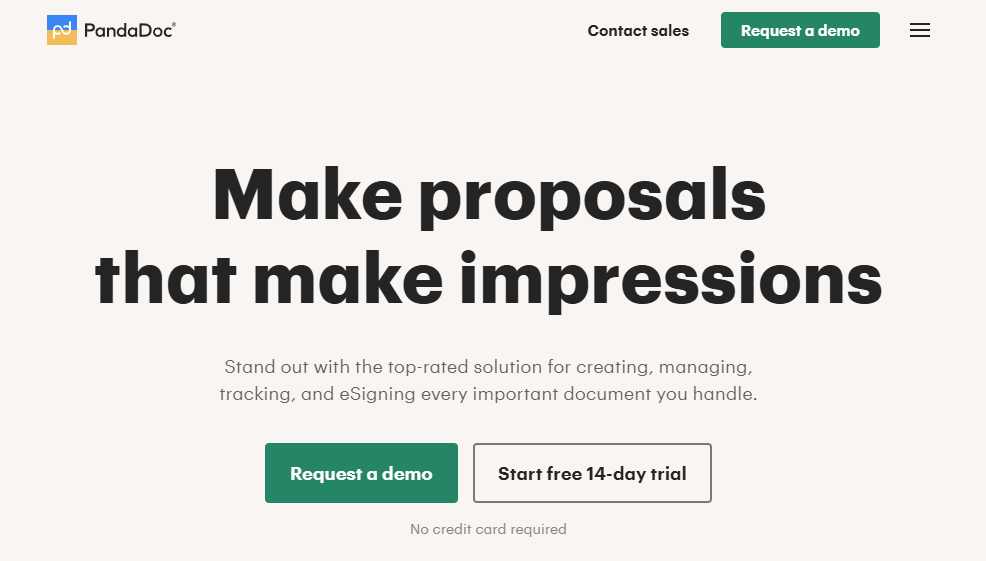
PandaDoc simplifies the creation, delivery, and signing of proposals, contracts, and quotes. With CRM integrations and powerful engagement analytics, it’s built to move deals across the finish line faster.
Key Features:
- Proposal templates that auto-populate using CRM data
- Engagement tracking: see which parts of a proposal get the most attention
- Built-in e-signatures
- Client collaboration and commenting
- Content library with reusable templates
- Conditional content display based on deal specifics
- Automated follow-up reminders
Pros:
- Speeds up proposal creation and reduces errors
- Real-time insights into buyer behavior
- Eliminates need for external e-sign tools
- Supports internal and client collaboration
Cons:
- Some learning curve with advanced templates
- May face adoption issues due to procurement policies
- Pricier for smaller teams with low document volume
Pricing:
- Free eSign Plan: Unlimited signing
- Essentials: $19/user/month
- Business: $49/user/month
- Enterprise: Custom pricing
27. DocuSign
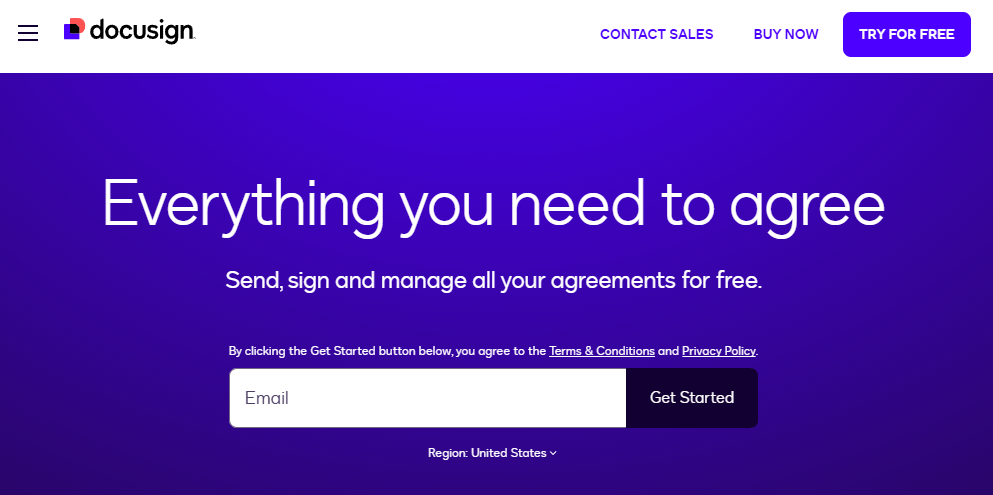
DocuSign is the gold standard for secure electronic signatures. While it focuses mostly on the signing phase, it offers key integrations and compliance features that streamline workflows for sales teams.
Key Features:
- Secure, legally binding e-signatures
- CRM and CPQ integrations
- Signer authentication and audit trails
- Bulk sending and payment collection options
- Mobile signing support
Pros:
- Recognized and trusted brand—easy client adoption
- Strong security and legal compliance
- Seamless CRM integrations
- Scalable for large teams or high-volume contracts
Cons:
- Limited document creation functionality
- Higher cost compared to simpler tools
- Complex features may require training
- Mobile signing occasionally glitchy
Pricing:
- Free Plan: 3 documents/month
- Standard: $25/user/month (billed annually)
- Business Pro: $40/user/month
- Enterprise: Custom pricing
28. Crystal Knows
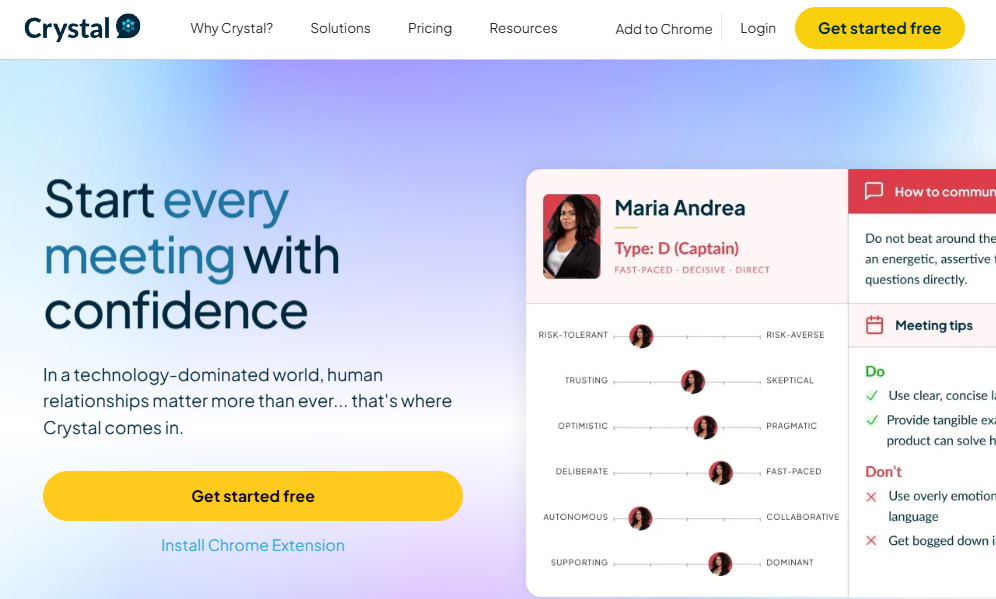
Crystal Knows uses AI to build personality profiles based on a prospect’s digital footprint, helping reps tailor their outreach to match communication styles and improve engagement.
Key Features:
- Personality profiles using DISC framework
- Email writing suggestions tailored to each profile
- Personality-based call prep and objection handling tips
- Integrations with LinkedIn and CRMs
- Insights for team collaboration and account-based selling
Pros:
- Improves cold outreach and rapport-building
- Helps customize communication for multiple decision-makers
- Saves time during prospect research
Cons:
- Accuracy depends on available online data
- Can raise privacy concerns with some prospects
- Less effective on people with minimal digital presence
- Cost may not be justifiable for occasional users
Pricing:
- Free Trial available
- Professional: $49/month ($39/month billed annually)
- Team plans: ~$500+/user/year
Conclusion
Sales automation provides a range of tools designed to streamline the sales process, from lead generation to closing deals. AI integration is a key trend, offering intelligent recommendations that help sales teams implement best practices automatically. For sales leaders, the challenge is selecting the right mix of tools that align with their workflow without overwhelming the team.
To navigate this, map out your sales process and identify bottlenecks. For lead generation, consider outreach tools; for stalled deals, use intelligence and forecasting platforms; for administrative tasks, explore CRM solutions; and for improving communication, focus on tools that enhance outreach and engagement. The right tools, aligned with your challenges, can optimize efficiency and drive growth.